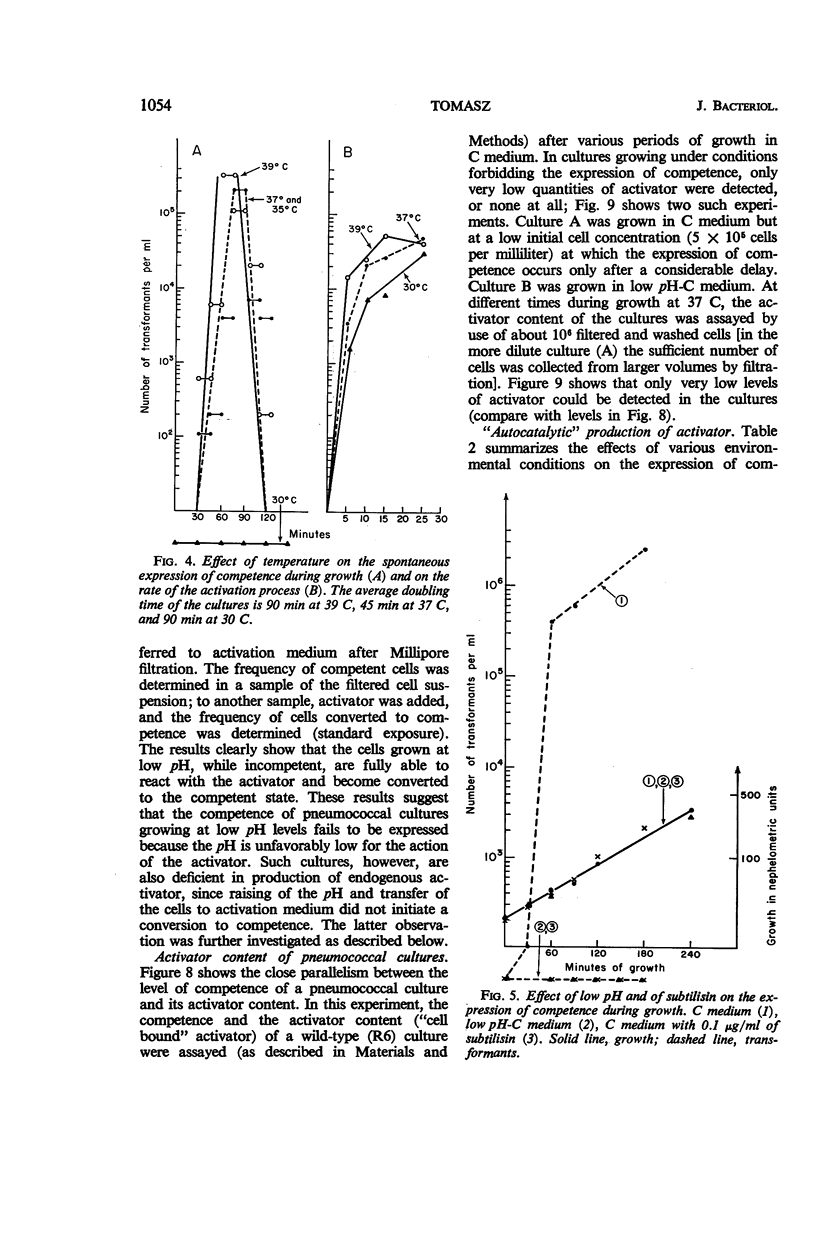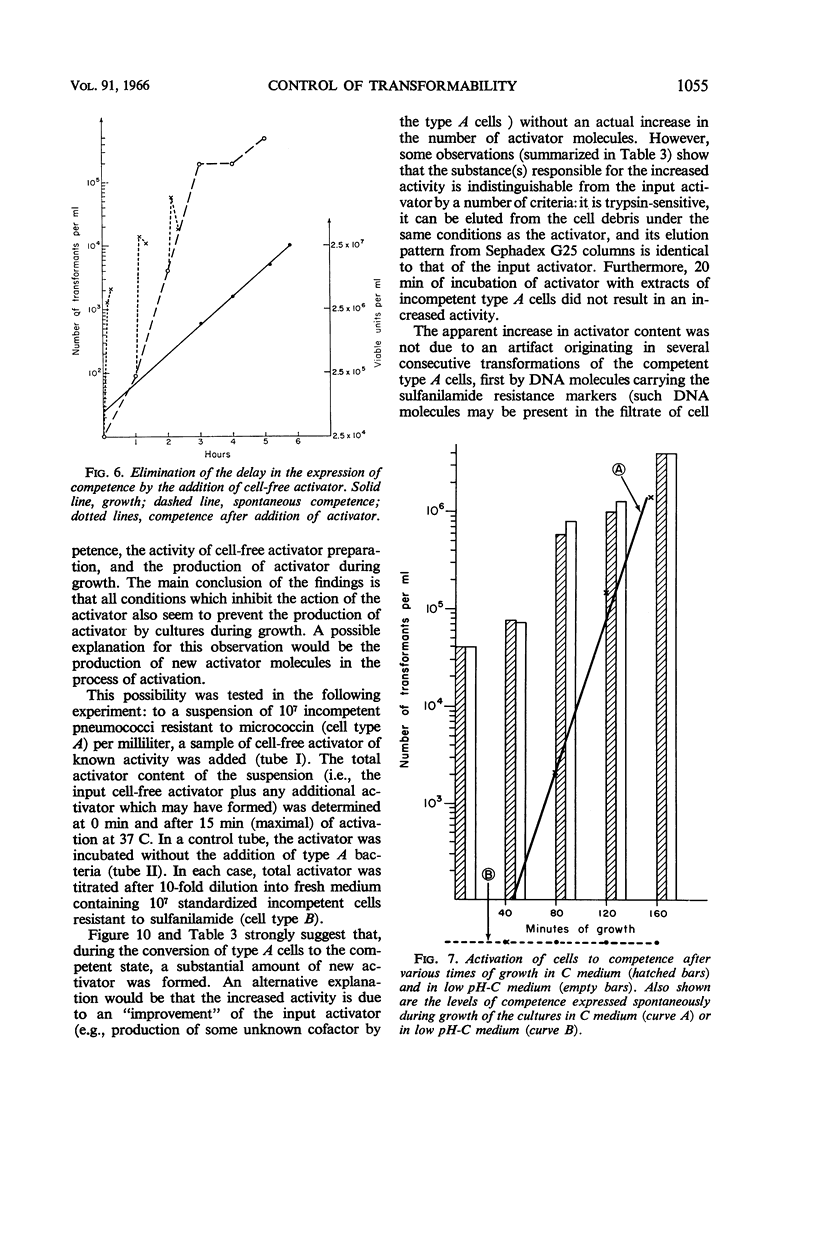Abstract
Tomasz, Alexander (The Rockefeller University, New York, N.Y.). Model for the mechanism controlling the expression of competent state in pneumococcus cultures. J. Bacteriol. 91:1050–1061. 1966.—The phenotypic expression of competence allowing the cells to absorb genetically active deoxyribonucleic acid molecules from their environment was examined in pneumococcal cultures growing under a variety of environmental conditions. The most important single parameter affecting the time course of this expression process was found to be the cell concentration. Constant high levels of competence could be maintained in cultures growing in a continuous-dilution device. The expression of competence seems to occur through a specific induction process “catalyzed” by a macromolecular cell product—the activator substance. Under most growth conditions, the availability of endogenous activator seems to limit the expression of competence. An “autocatalytic” production of activator ensues during the activation of cells to the competent state. Evidence is presented for physiological influences affecting the cell's capacity to react with the activator. A physiological model is proposed for the control of the competent state in pneumococcus.
Full text
PDF











Selected References
These references are in PubMed. This may not be the complete list of references from this article.
- Charpak M., Dedonder R. Production d'un "facteur de compétence" soluble par Bacillus subtilis Marburg ind 168. C R Acad Sci Hebd Seances Acad Sci D. 1965 May 24;260(21):5638–5641. [PubMed] [Google Scholar]
- EPHRUSSI-TAYLOR H. Current status of bacterial transformations. Adv Virus Res. 1955;3:275–307. doi: 10.1016/s0065-3527(08)60639-9. [DOI] [PubMed] [Google Scholar]
- FOX M. S. Phenotypic expression of a genetic property introduced by deoxyribonucleate. J Gen Physiol. 1959 Mar 20;42(4):737–748. doi: 10.1085/jgp.42.4.737. [DOI] [PMC free article] [PubMed] [Google Scholar]
- Hotchkiss R. D. CYCLICAL BEHAVIOR IN PNEUMOCOCCAL GROWTH AND TRANSFORMABILITY OCCASIONED BY ENVIRONMENTAL CHANGES. Proc Natl Acad Sci U S A. 1954 Feb;40(2):49–55. doi: 10.1073/pnas.40.2.49. [DOI] [PMC free article] [PubMed] [Google Scholar]
- OTTOLENGHI E., HOTCHKISS R. D. Release of genetic transforming agent from pneumococcal cultures during growth and disintegration. J Exp Med. 1962 Oct 1;116:491–519. doi: 10.1084/jem.116.4.491. [DOI] [PMC free article] [PubMed] [Google Scholar]
- Pakula R., Hauschild A. H. The effect of "competase" on DNA uptake in provoked transformation of a streptococcus. Can J Microbiol. 1965 Oct;11(5):823–827. doi: 10.1139/m65-111. [DOI] [PubMed] [Google Scholar]
- THOMAS R. Recherches sur la cinétique des transformations bactériennes. Biochim Biophys Acta. 1955 Dec;18(4):467–481. doi: 10.1016/0006-3002(55)90137-2. [DOI] [PubMed] [Google Scholar]
- TOMASZ A., HOTCHKISS R. D. REGULATION OF THE TRANSFORMABILITY OF PHEUMOCOCCAL CULTURES BY MACROMOLECULAR CELL PRODUCTS. Proc Natl Acad Sci U S A. 1964 Mar;51:480–487. doi: 10.1073/pnas.51.3.480. [DOI] [PMC free article] [PubMed] [Google Scholar]
- Tomasz A. Control of the competent state in Pneumococcus by a hormone-like cell product: an example for a new type of regulatory mechanism in bacteria. Nature. 1965 Oct 9;208(5006):155–159. doi: 10.1038/208155a0. [DOI] [PubMed] [Google Scholar]
- Tomasz A., Mosser J. L. On the nature of the pneumococcal activator substance. Proc Natl Acad Sci U S A. 1966 Jan;55(1):58–66. doi: 10.1073/pnas.55.1.58. [DOI] [PMC free article] [PubMed] [Google Scholar]


